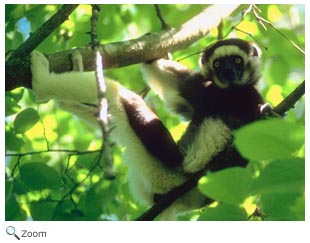Indridae - indris, sifakas,
avahis
 There are 18 species in this family and they are all found in
Madagascar. They live in tropical forests are herbivores. They live in small groups in trees. Their legs are longer than their arms. They have five digits on their hands and feet and have an opposable big toe. They have furless black faces, and most species have long tails. There are 18 species in this family and they are all found in
Madagascar. They live in tropical forests are herbivores. They live in small groups in trees. Their legs are longer than their arms. They have five digits on their hands and feet and have an opposable big toe. They have furless black faces, and most species have long tails.
The species in this family spend most of their time in trees, but they do come down onto they ground. When they are on the ground they stand on their hind legs with their arms in the air and bound across the ground.
Indrids are social animals, and they live in family groups made up of 2-14 individuals. They are herbivores and eat fruit, flowers, and leaves.
World Status Key
 Least Concern Least Concern  Near Threatened Near Threatened  Vulnerable Vulnerable  Endangered Endangered  Critically Endangered Critically Endangered  Extinct Wild Extinct Wild  Extinct Extinct
Status taken from ICUN Redlist. If no status is listed, there is not enough data to establish status, or there is no status data for the species.
US Status Key
 Threatened in US Threatened in US  Threatened in NH Threatened in NH  Endangered in US Endangered in US  Endangered in NH Endangered in NH  Introduced Introduced
Status taken from US Fish and Wildlife and NH Fish and Game
New Hampshire Species |
|
North/Central American Species |
| None |
|
None |
Additional Information Resource Key
 Profile Profile  Photos Photos  Video Video  Audio Audio
Bemaraha Woolly Lemur -
Avahi cleesei    
The Bemaraha wooly lemur's Latin name, Avahi cleesei, is derived from the name of British comedian and actor John Cleese.
Source: Arkive Intended Audience: General Reading Level: Middle School Teacher Section: Yes
Coquerel's Sifaka - Propithecus coquereli    
Zoboo from the PBS children's series Zooboomafoo is a Coquerel's sifaka.
Source: Los Angeles Zoo Intended Audience: General Reading Level: Middle School Teacher Section: Yes
Coquerel's Sifaka - Propithecus coquereli     
Coquerel's sifaka is sometimes listed as a subspecies of Verreaux's sifaka.
Source: St. Louis Zoo Intended Audience: General Reading Level: Middle School Teacher Section: Yes
Coquerel's Sifaka - Propithecus coquereli     
Coquerel's sifakas live in dry lowland forests.
Source: Philadelphia Zoo Intended Audience: General Reading Level: Middle School Teacher Section: Yes
Diademed Sifaka - Propithecus diadema    
The diademed sifaka is found in mid-altitude rainforests.
Source: Arkive Intended Audience: General Reading Level: Middle School Teacher Section: Yes
Diademed Sifaka - Propithecus diadema    
The diademed sifaka has a black face surrounded by white fur.
Source: Animal Diversity Web Intended Audience: General Reading Level: Middle School Teacher Section: Yes
Gmelin's Woolly Lemur - Avahi laniger    
Gmelin's wooly lemur spends long periods of time sleeping.
Source: Animal Diversity Web Intended Audience: General Reading Level: Middle School Teacher Section: Yes
Golden-crowned Sifaka - Propithecus tattersalli     
The Golden-crowned sifaka is the smallest of the sifakas.
Source: Arkive Intended Audience: General Reading Level: Middle School Teacher Section: Yes
Golden-crowned Sifaka - Propithecus tattersalli   
Golden-crowned sifakas are social animals and live in groups of 2-13 individuals.
Source: Animal Diversity Web Intended Audience: General Reading Level: Middle School Teacher Section: Yes
Indri - Indri indri    
Indris are found in the northeastern part of Madagascar.
Source: Animal Diversity Web Intended Audience: General Reading Level: Middle School Teacher Section: Yes
Western Woolly Lemur - Avahi occidentalis    
The Western Wooly Lemur. is also known as the Lorenz Von Liburnau's Wooly Lemur.
Source: Arkive Intended Audience: General Reading Level: Middle School Teacher Section: Yes
Milne-edward's Sifaka - Propithecus edwardsi    
Milne-Edward's sifaka young are carried on their mother's stomach until they are 3 to 4 weeks old.
Source: Animal Diversity Web Intended Audience: General Reading Level: Middle School Teacher Section: Yes
Perrier's Sifaka - Propithecus perrieri   
Perrier's sifakas are found in the northeastern and northern parts of Madagascar.
Source: Animal Diversity Web Intended Audience: General Reading Level: Middle School Teacher Section: Yes
Verreaux's Sifaka - Propithecus verreauxi     
Verreaux's sifaka is known for leaping across the ground with its arms held high.
Source: Arkive Intended Audience: General Reading Level: Middle School Teacher Section: Yes Verreaux's Sifaka - Propithecus verreauxi   
Verreaux's sifakas are found in the western and southwestern regions of Madagascar.
Source: Animal Diversity Web Intended Audience: General Reading Level: Middle School Teacher Section: Yes |

